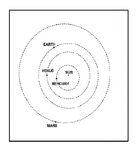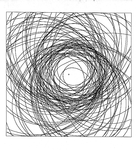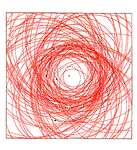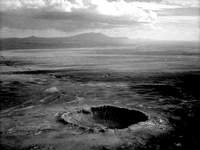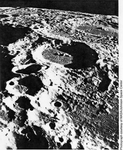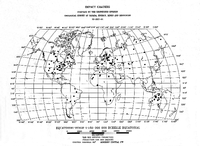
|
| 1.1 | 1.2 | 1.3 | Contents |
1.2 The International NEO Detection Workshop
The United States House of Representatives, in its NASA Multiyear Authorization Act of 1990 (26 September 1990), included the following language:
"The Committee believes that it is imperative that the detection rate of Earth-orbit-crossing asteroids must be increased substantially, and that the means to destroy or alter the orbits of asteroids when they threaten collision should be defined and agreed upon internationally.
"The chances of the Earth being struck by a large asteroid are extremely small, but since the consequences of such a collision are extremely large, the Committee believes it is only prudent to assess the nature of the threat and prepare to deal with it. We have the technology to detect such asteroids and to prevent their collision with the Earth.
"The Committee therefore directs that NASA undertake two workshop studies. The first would define a program for dramatically increasing the detection rate of Earth-orbit-crossing asteroids; this study would address the costs, schedule, technology, and equipment required for precise definition of the orbits of such bodies. The second study would define systems and technologies to alter the orbits of such asteroids or to destroy them if they should pose a danger of life on Earth. The Committee recommends international participation in these studies and suggests that they be conducted within a year of the passage of this legislation."
The present report of the NASA International Near-Earth Object Detection Workshop is the direct result of this Congressional request to NASA. A second NASA workshop on the question of altering asteroid orbits is scheduled for 1992.
The NASA International Near-Earth Object Detection Workshop was organized in the spring of 1991 and held three formal meetings: on June 30 - July 3 at the San Juan Capistrano Research Institute, on September 24-25 at the NASA Ames Research Center, and on November 5 in Palo Alto, California. The group has the following membership of 24 individuals from four continents.
- Richard Binzel (Massachusetts Institute of Technology, USA)
- Edward Bowell (Lowell Observatory, USA)
- Clark Chapman (Planetary Science Institute, USA)
- Louis Friedman (The Planetary Society, USA)
- Tom Gehrels (University of Arizona, USA)
- Eleanor Helin (Caltech/NASA Jet Propulsion Laboratory, USA)
- Brian Marsden (Harvard/Smithsonian Center for Astrophysics, USA)
- Alain Maury (Observatoire de la Cote d'Azur, France)
- Thomas Morgan (NASA Headquarters, USA)
- David Morrison (NASA Ames Research Center, USA)
- Karri Muinonen (Helsinki University, Finland)
- Steven Ostro (Caltech/NASA Jet Propulsion Laboratory, USA)
- John Pike (Federation of American Scientists, USA)
- Jurgen Rahe (NASA Headquarters, USA)
- R. Rajamohan (Indian Institute of Astrophysics, India)
- John Rather (NASA Headquarters, USA)
- Ken Russell (Anglo-Australian Observatory, Australia)
- Eugene Shoemaker (U.S. Geological Survey, USA)
- Andrej Sokolsky (Institute for Theoretical Astronomy, USSR)
- Duncan Steel (Anglo-Australian Observatory, Australia)
- David Tholen (University of Hawaii, USA)
- Joseph Veverka (Cornell University, USA)
- Faith Vilas (NASA Johnson Space Center, USA)
- Donald Yeomans (Caltech/NASA Jet Propulsion Laboratory, USA)
| 1.1 | 1.2 | 1.3 | Contents |
1.3 Approach to the Problem
As described in the following chapters of this report, the
workshop group has analyzed the nature of the hazard and defined
a practical program for the detection of potentially catastrophic
impacts. The greatest risk is from the impact of the largest
objects -- those with diameters greater than 1 km. Such impacts,
which occur on average from once to several times per million
years, are qualitatively as well as quantitatively different
from any other natural disasters in that their consequences are
global, affecting the entire planet. How, then, should we approach
the problem of discovering and tracking these objects?
About 90 percent of the potential Earth-impacting projectiles are near-Earth asteroids or short-period comets, called collectively NEOs (Near Earth Objects). The other 10 percent are intermediate or long-period comets (those with periods longer than 20 years), which are treated separately since they they spend so little time in near-Earth space. The NEOs have orbits that closely approach or intersect that of the Earth. Their normal orbital motion brings them relatively near the Earth at intervals of a few years, permitting their discovery. The objective of an NEO survey is to find these objects during their periodic approaches to the Earth, to calculate their long-term orbital trajectories, and to identify any that may impact the Earth over the next several centuries. If any appear to be on Earth-impact trajectories, there will generally be a period of at least several decades during which to take corrective action. It should be emphasized that we are not discussing either a short-range search nor a quick-response defense system. The chance that an NEO will be discovered less than a few years before impact is vanishingly small. The nature of the NEO orbits allows us to carry out a deliberate, comprehensive survey with ample time to react if any threatening NEO is found. In contrast, however, the warning time for impact from a long-period comet might be as short as two years, requiring a different class of response.
In order to carry out a deliberate and comprehensive search, we must detect, over a period of a decade or more, the NEOs larger than our 1-km size threshold that pass near the Earth. This requires that we monitor a region of space extending outward from the orbit of the Earth approximately as far as the inner edge of the main asteroid belt, at a distance of 200 million kilometers. The easiest way to detect these NEOs is by observing their reflected sunlight, although they can also be seen in the infrared using their emitted thermal radiation. More exotic technologies are not appropriate; radar, in particular, is limited to targets close to the Earth, and so is unsuitable to a survey extending 200 million kilometers into space. In principle, the survey could be carried out either from the ground or from orbit. The brightness of a 1-km NEO at 200 million kilometers, assuming a reflectivity of 3 percent or more, corresponds to stellar magnitude 22. Although they are quite faint, such objects are readily detectable with conventional ground-based telescopes and can be distinguished from background stars by their characteristic motion. Thus there is no requirement for a more expensive space-based system. This brightness limit also determines the minimum telescope aperture of about 2 m that is required for a complete survey. Thus we have it within our current capability to construct a network of survey telescopes at relatively modest cost that can discover and track essentially all of the NEOs greater than 1 km in diameter. In addition, this same network of optical survey telescopes will be capable of detecting most incoming intermediate- or long-period comets and determining if any of them is has the potential to strike the Earth. However, the time between detection and possible impact will be much shorter for the long-period comets, probably no more than two years.
The survey program described in this report has the potential to alter fundamentally the way we view the threat of cosmic impacts. To date we have talked about a relatively undefined threat, to be discussed in terms of probabilities or statistical risks. While we know that such impacts must take place from time to time, we do not know if there are any specific bodies in space might impact the Earth over the next few centuries. If this search program is carried out, however, we can answer this question to at least the 75 percent confidence level. If such an object is found, then we can turn our attention to dealing with the threat it poses. In other words, we have the capability for at least a 75 percent reduction in the hazard posed by cosmic impacts.
|
|
|
